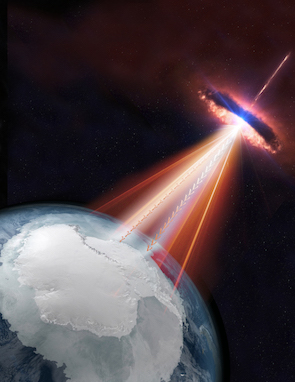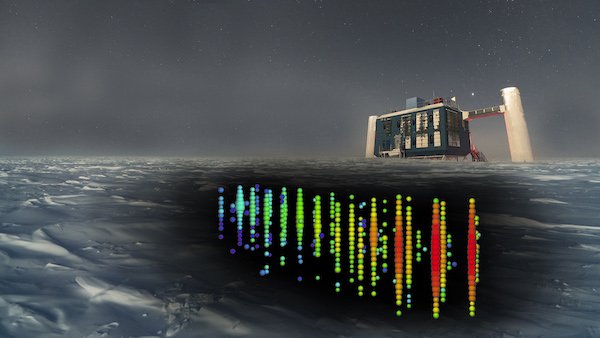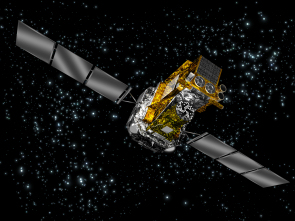INTEGRAL joins multi-messenger campaign to study high-energy neutrino source
12 July 2018
An international team of scientists has found first evidence of a source of high-energy neutrinos: a flaring active galaxy, or blazar, 4 billion light years from Earth. Following a detection by the IceCube Neutrino Observatory on 22 September 2017, ESA's INTEGRAL satellite joined a collaboration of observatories in space and on the ground that kept an eye on the neutrino source, heralding the thrilling future of multi-messenger astronomy. |
| Artist's impression of blazar neutrinos and gamma rays reaching Earth. Credit: IceCube/NASA |
Neutrinos are nearly massless, ‘ghostly’ particles that travel essentially unhindered through space at close to the speed of light [1]. Despite being some of the most abundant particles in the Universe – 100 000 billion pass through our bodies every second – these electrically neutral, subatomic particles are notoriously difficult to detect because they interact with matter incredibly rarely.
While primordial neutrinos were created during the Big Bang, more of these elusive particles are routinely produced in nuclear reactions across the cosmos. The majority of neutrinos arriving at Earth derive from the Sun, but those that reach us with the highest energies are thought to stem from the same sources as cosmic rays – highly energetic particles originating from exotic sources outside the Solar System.
Unlike neutrinos, cosmic rays are charged particles and so their path is bent by magnetic fields, even weak ones. The neutral charge of neutrinos instead means they are unaffected by magnetic fields, and because they pass almost entirely through matter they can be used to trace a straight path all the way back to their source.
Acting as ‘messengers’, neutrinos directly carry astronomical information from the far reaches of the Universe. Over the past decades, several instruments have been built on Earth and in space to decode their messages, though detecting these particles is no easy feat. In particular, the source of high-energy neutrinos has, until now, remained unproven.
On 22 September 2017, one of these high-energy neutrinos arrived at the IceCube Neutrino Observatory at the South Pole [2]. The event was named IceCube-170922A.
The IceCube observatory, which encompasses a cubic kilometre of deep, pristine ice, detects neutrinos through their secondary particles, muons. These muons are produced on the rare occasion that a neutrino interacts with matter in the vicinity of the detector, and they create tracks, kilometres in length, as they pass through layers of Antarctic ice. Their long paths mean their position can be well defined, and the source of the parent neutrino can be pinned down in the sky.
During the 22 September event, a traversing muon deposited 22 TeV of energy in the IceCube detector. From this, scientists estimated the energy of the parent neutrino to be around 290 TeV, indicating a 50 percent chance that it had an astrophysical origin beyond the Solar System.
 |
| Neutrino detection at the IceCube observatory. Credit: IceCube Collaboration/NSF |
When the origin of a neutrino cannot be robustly identified by IceCube, like in this case, multi-wavelength observations are required to investigate its source. So, following the detection, IceCube scientists circulated the coordinates in the sky of the neutrino’s origin, inferred from their observations, to a worldwide network of ground and space-based observatories working across the full electromagnetic spectrum.
These included NASA's Fermi gamma-ray space telescope and the Major Atmospheric Gamma-Ray Imaging Cherenkov (MAGIC) on La Palma, in the Canary Islands, which looked to this portion of the sky and found the known blazar, TXS 0506+056, in a ‘flaring’ state – a period of intense high-energy emission – at the same time the neutrino was detected at the South Pole.
Blazars are the central cores of giant galaxies that host an actively accreting supermassive black-hole at their heart, where matter spiralling in forms a hot, rotating disc that generates enormous amounts of energy, along with a pair of relativistic jets.
These jets are colossal columns that funnel radiation, photons and particles – including neutrinos and cosmic rays – tens of light years away from the central black hole at speeds very close to the speed of light. A specific feature of blazars is that one of these jets happens to point towards Earth, making its emission appear exceptionally bright.
Scientists around the world began observing this blazar – the likely source of the neutrino detected by IceCube – in a variety of wavelengths, from radio waves to high-energy gamma rays. ESA's INTEGRAL gamma-ray observatory was part of this international collaboration [3].
“This is a very important milestone to understanding how high-energy neutrinos are produced,” says Carlo Ferrigno from the INTEGRAL Science Data Centre at the University of Geneva, Switzerland.
“There have been previous claims that blazar flares were associated with the production of neutrinos, but this, the first confirmation, is absolutely fundamental. This is an exciting period for astrophysics,” he adds.
 |
| Artist's impression of INTEGRAL. Credit: ESA |
INTEGRAL, which surveys the sky in hard X-rays and soft gamma rays, is also sensitive to transient high-energy sources across the whole sky. At the time the neutrino was detected, it did not record any burst of gamma rays from the location of the blazar, so scientists were able to rule out prompt emissions from certain sources, such as a gamma-ray burst.
After the neutrino alert from IceCube, INTEGRAL pointed to this area of the sky on various occasions between 30 September and 24 October 2017 with its wide-field instruments, and it did not observe the blazar to be in a flaring state in the hard X-ray or soft gamma-ray range.
The fact that INTEGRAL could not detect the source in the follow-up observations provided significant information about this blazar, allowing scientists to place a useful upper limit on its energy output during this period.
“INTEGRAL was important in constraining the properties of this blazar, but also in allowing scientists to exclude other neutrino sources such as gamma-ray bursts,” explains Volodymyr Savchenko from the INTEGRAL Science Data Centre, who led the analysis of the INTEGRAL data.
With facilities spread across the globe and in space, scientists now have the capability to detect a plethora of 'cosmic messengers' travelling vast distances at extremely high speeds, in the form of light, neutrinos, cosmic rays, and even gravitational waves.
“The ability to globally marshal telescopes to make a discovery using a variety of wavelengths in cooperation with a neutrino detector like IceCube marks a milestone in what scientists call multi-messenger astronomy,” says Francis Halzen from the University of Wisconsin–Madison, USA, lead scientist for the IceCube Neutrino Observatory.
By combining the information gathered by each of these sophisticated instruments to investigate a wide range of cosmic processes, the era of multi-messenger astronomy has truly entered the phase of scientific exploitation.
ESA’s high-energy space telescopes are fully integrated into this network of large multi-messenger collaborations, as demonstrated during the recent detection of gravitational waves with a corresponding gamma-ray burst – the latter detected by INTEGRAL – released by the collision of two neutron stars, and in the subsequent follow-up campaign, with contributions by INTEGRAL as well as the XMM-Newton X-ray observatory.
Pooling resources from these and other observatories is key for the future of astrophysics, fostering our ability to decode the messages that reach us from across the Universe.
“INTEGRAL is the only observatory available in the hard X-ray and soft gamma-ray domain that has the ability to perform dedicated imaging and spectroscopy, as well as having an instantaneous all-sky view at any time,” notes Erik Kuulkers, INTEGRAL project scientist at ESA.
“After more than 15 years of operations, INTEGRAL is still at the forefront of high-energy astrophysics.”
Notes
[1] Described by Frederick Reines, one of the scientists who made the first neutrino detection, as “... the most tiny quantity of reality ever imagined by a human being,” one neutrino is estimated to contain one millionth of the mass of an electron.
[2] The IceCube Collaboration is funded primarily by the National Science Foundation and is operated by a team headquartered at the University of Wisconsin–Madison, USA. The research efforts, including critical contributions to the detector operation, are supported by funding agencies in Australia, Belgium, Canada, Denmark, Germany, Japan, New Zealand, Republic of Korea, Sweden, Switzerland, the United Kingdom, and the USA.
[3] These results are detailed in the paper “Multimessenger observations of a flaring blazar coincident with high-energy neutrino IceCube-170922A” by The IceCube, Fermi-LAT, MAGIC, AGILE, ASAS-SN, HAWC, H.E.S.S, INTEGRAL, Kanata, Kiso, Kapteyn, Liverpool telescope, Subaru, Swift/NuSTAR, VERITAS, and VLA/17B-403 teams, published in Science. DOI:10.1126/science.aat1378
For further information, please contact:
Erik Kuulkers
ESA INTEGRAL Project Scientist
European Space Agency
Tel: +31 6 30249526
Email: Erik.Kuulkers![]() esa.int
esa.int
Carlo Ferrigno
INTEGRAL Science Data Centre
University of Geneva, Switzerland
Email: Carlo.Ferrigno![]() unige.ch
unige.ch
Volodymyr Savchenko
INTEGRAL Science Data Centre
University of Geneva, Switzerland
Email: Volodymyr.Savchenko![]() unige.ch
unige.ch
Francis Halzen
IceCube Principal Investigator
University of Wisconsin–Madison, USA
Email: francis.halzen![]() icecube.wisc.edu
icecube.wisc.edu
Sílvia Bravo Gallart
IceCube Press Office
University of Wisconsin–Madison, USA
Email: silvia.bravo![]() icecube.wisc.edu
icecube.wisc.edu
Markus Bauer
ESA Science Communication Officer
Tel: +31 71 565 6799
Mob: +31 61 594 3 954
Email: markus.bauer![]() esa.int
esa.int



